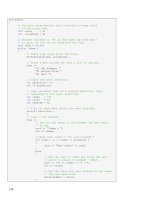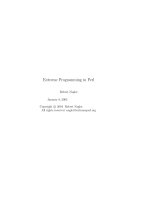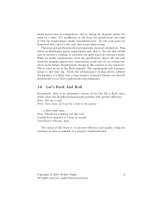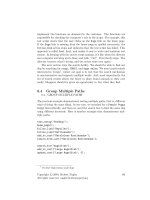Extreme Programming in Perl Robert Nagler phần 6 doc
Bạn đang xem bản rút gọn của tài liệu. Xem và tải ngay bản đầy đủ của tài liệu tại đây (144.42 KB, 15 trang )
checking, and printing are contained in separate routines. Each routine
is responsible for one and only one behavior.
• The localtime and gmtime calls are now in the correct order. This
defect in the original version only became apparent to me when I
separated the two output lines.
• Argument type validation is consistent, because it has been isolated
into a single routine ( plan arg assert) that is used for all three
parameters. Several new cases are caught. For example, passing undef
to tests or passing both tests and test (deprecated form) is not
allowed.
• Carp::croak unrecognized directive warning is printed once instead of
a warning per unrecognized directive. The check for unrecognized
directives still does not fail fast (croak or die). I would have liked
to correct this, because passing an invalid directives to plan probably
indicates a broken test. However, the broad user base of Test makes
this change infeasible. Somebody may be depending on the behavior
that this is only a warning.
• Two temporary variables (@todo and $x) were eliminated by using a
functional programming style. By avoiding temporary variables, we
simplify algorithms and eliminate ordering dependencies. See the It’s
a SMOP chapter for a longer example of functional programming.
• $planned was eliminated after $ TODO was converted to a reference.
$planned is known as a denormalization, because it can be computed
from another value ($ TODO in this case). Normal form is when data
structures and databases store the sources of all information once and
only once.
• plan print writes a single string. The seven calls print were unnec-
essary duplication. I often use logical operators instead of imperative
statements to avoid the use of temporary variables, which are another
form of duplication (denormalization).
• The return value from plan is better represented as an empty return,
because it handles list and scalar return contexts correctly. This is a
subtle point about return, and it actually involves an interface change.
The following use assigns an empty list:
Copyright
c
2004 Robert Nagler
All rights reserved
76
my(@result) = Test::plan(tests => 1);
In the old version, @result would contain the list (undef), that is, a
list with a single element containing the value undef.
• The check for an o dd number of arguments is unnecessary, because the
assignment to a hash will yield a warning and the argument parsing is
more rigorous (no argument may be undef, for example).
• print encapsulates the output function that is used throughout Test.
The concept that the output is directed to $TESTOUT is only expressed
once.
• The global variables are named consistently ($ ONFAIL and $ TODO).
I name global variables in uppercase. I use a leading underscore to
identify variables and routines which are to be used internally to the
package only.
$TESTOUT was not renamed, because it is exported from the package
Test. In general, variables should never be exported, but this would
be an interface change, not a refactoring.
• I fully qualify all names defined outside a package (Carp::carp and
Carp::croak). This helps the reader to know what is defined locally as
well as enabling him to find the implementation of or documentation
for external functions quickly. I apply this guideline to perl modules.
In specialized Perl scripts, such as, templates and tests, I prefer the
brevity of the unqualified form. For example, in the unit test example
above, I used ok, not Test::ok.
• carp and croak print the file and line number for you, so including
Test::plan in the error string is unnecessarily redundant.
• The spe lling error (verison) in the $MacPerl::Version output string
was corrected.
• The two calls to sprintf and scalar are unnecessary. The concatena-
tion operator (dot) is sufficient, more succinct, and used consistently.
• The old style call syntax (&Win32::BuildNumber()) was eliminated,
because it was not used in all places ( reset globals()).
• The comment # Retval never used: was removed, because it is su-
perfluous, and it indicates an unprovable assertion. You can’t know
that the return value won’t be used.
Copyright
c
2004 Robert Nagler
All rights reserved
77
• The comment # guard against -l and was removed, because
the context of print is enough to explain why the local call is
needed.
8
Even if you don’t know what $, and $\ are, you know they
are relevent only to the call to print, since that’s the only thing that
it could possibly affect.
9.9 Refactoring
Now kids, don’t try this at work. Refactorings and small corrections are
not an end to themselves. The do not add business value–unless you are
writing your coding style guideline as is the case here. Refactorings need to
be related to the task at hand. For example, if there I was given a story to
fix the minor defec ts in plan or to add automatic test case counting, then
I would have refactored the code to allow for those changes, and possibly
a bit more. However, random and extensive refactoring as I’ve done here
is worthless. The original version works just fine, and all the corrections
are minor. If you spend your days refactoring and making small corrections
without explicit customer approval, you’ll probably lose your job.
The new plan is also not just a refactoring. When an interface changes,
it’s only a refactoring if all its uses are changed simultaneously. For public
APIs like this one, that’s impossible to do. In this particular case, I took
a chance that the return value of plan was not used in this rather obscure
way, that is, expecting a single list containing undef.
9.10 Input Validation
Perl is a dynamically typed language. The routine plan contains a set of
type assertions, and the refactored version expanded on them. Is this the
best way to write dynamically typed code?
but It depends. In this case, explicit type checking is possibly overkill.
For example, the $
TODO and $ ONFAIL are dereferenced elsewhere in the
package. Dereferencing a non-reference terminates execution in Perl, so the
error will be caught anyway. Since Test is only used in test programs, it’s
probably sufficient to catch an error at any point.
On the other hand, Test is a very public API, which means it has a broad
and unknown user base. Explicit type checking almost always yields more
8
In XP, “we comment methods only after doing everything possible to make the
metho d not need a comment.” See for a doc-
ument about documentation by XP’s founders.
Copyright
c
2004 Robert Nagler
All rights reserved
78
easily understood error messages than implicit error checks. This helps users
debug incorrect parameters. plan is only called once during a test execution
so the performance impact of the additional checking is insignificant.
Here are some guidelines we use to determine when to add type asser-
tions:
• Always validate data from untrusted sources, for example, users or
third party services. It’s important to give informative error messages
to end users. This type of validation occurs at the outermost level of
the system, where meaningful error messages can be returned with the
appropriate context.
• Add type assertions to low level modules that define the data types,
and leave them out at the middle levels where they would be redun-
dant. There may be a performance trade off here. In general, the more
public the API, the more important validation is. For e xample, plan
defines and asserts that the test count is positive integer.
• Assert what is likely to b e wrong.
• Write deviance tests, that is, tests which result in exceptions or type
validation errors. Add assertions if the tests don’t pass. The appro-
priateness of a particular type assertion is often hard to assess. Don’t
sweat it. You’ll learn what’s appropriate as your system evolves.
• Don’t expect to get it right, and think about the consequences if you
get it wrong. The more that’s at stake, the more important assertions
are.
9
Writing robust code is hard. If you add too many assertions, their sheer
volume will introduce more defects than they were intended to prevent. Add
too few assertions, and one day you’ll find a cracker who has compromised
your system, or worse. Expect the code to evolve as it gets used.
9.11 You’d Rather Die
Nothing is more boring than reading someone’s opinion about coding style.
Rather than kill off my readership, I’ll stop here. When you get up to stretch
your legs, I’d like you to walk away with five points:
• An XP team needs a consistent coding style.
9
Thanks to Ged Haywoo d for reminding me of this one.
Copyright
c
2004 Robert Nagler
All rights reserved
79
• It doesn’t matter what the style is, as long as everyone agrees to adhere
to it.
• Take re factoring into consideration when determining your coding
style.
• Do the simplest thing that could possibly work when writing new code.
• Simplify your design so that concepts are expressed once and only
once.
Copyright
c
2004 Robert Nagler
All rights reserved
80
Chapter 10
Logistics
Failure is not an option. It comes bundled with the software.
– Anonymous
This chapter is under construction.
81
Copyright
c
2004 Robert Nagler
All rights reserved
82
Chapter 11
Test-Driven Design
The belief that a change will be e asy to do correctly makes it
less likely that the change will be done correctly.
– Gerald Weinberg
1
An XP programmer writes a unit test to clarify his intentions before
he makes a change. We call this test-driven design (TDD) or test-first
programming, because an API’s design and implementation are guided by
its tes t cases. The programmer writes the test the way he wants the API to
work, and he implements the API to fulfill the expectations set out by the
test.
Test-driven design helps us invent testable and usable interfaces. In
many ways, testability and usability are one in the same. If you can’t
write a test for an API, it’ll probably be difficult to use, and vice-versa.
Test-driven design gives feedback on usability before time is wasted on the
implementation of an awkward API. As a bonus, the test documents how
the API works, by example.
All of the above are good things, and few would argue with them. One
obvious concern is that tes t-driven design might slow down development. It
does take time to write tests, but by writing the tests first, you gain insight
into the implementation, which speeds development. Debugging the imple-
mentation is faster, too, thanks to immediate and reproducible feedback
that only an automated test can provide.
Perhaps the greatest time savings from unit testing comes a few months
or years after you write the test, when you need to extend the API. The
1
Quality Software Management: Vol. 1 Systems Thinking, Gerald Weinberg, Dorset
House, 1991, p. 236.
83
unit test not only provides you with reliable documentation for how the
API works, but it also validates the assumptions that went into the design
of the API. You can be fairly sure a change didn’t break anything if the
change passes all the unit tests written before it. Changes that fiddle with
fundamental API assumptions cause the costliest defects to debug. A com-
prehensive unit test suite is probably the most effective defense against such
unwanted changes.
This chapter introduces test-driven design through the implementation
of an exponential moving average (EMA), a simple but useful mathemat-
ical function. This chapter also explains how to use the CPAN modules
Test::More and Test::Exception.
11.1 Unit Tests
A unit test validates the programmer’s view of the application. This is quite
different from an acceptance test, which is written from the customer’s per-
spective and tests end-user functionality, usually through the same interface
that an ordinary user uses. In constrast, a unit test exercises an API, for-
mally known as a unit. Usually, we test an entire Perl package with a single
unit test.
Perl has a strong tradition of unit testing, and virtually every CPAN
module comes with one or more unit tests. There are also many test frame-
works available from CPAN. This and subsequent chapters use Test::More,
a popular and well doc umented test module.
2
I also use Test::Exception
to test deviance cases that result in calls to die.
3
11.2 Test First, By Intention
Test-driven design takes unit testing to the extreme. Before you write the
code, you write a unit test. For example, here’s the first test case for the
EMA (exponential moving average) module:
use strict;
use Test::More tests => 1;
BEGIN {
2
Part of the Test-Simple distribution, available at
I used version 0.47 for this book.
3
Version 0.15 used here. Available at />Exception
Copyright
c
2004 Robert Nagler
All rights reserved
84
use_ok(’EMA’);
}
This is the minimal Test::More test. You tell Test::More how many tests
to expect, and you import the module with use ok as the first test case . The
BEGIN ensures the module’s prototype s and functions are available during
compilation of the rest of the unit test.
The next step is to run this test to make sure that it fails:
% perl -w EMA.t
1 1
not ok 1 - use EMA;
# Failed test (EMA.t at line 4)
# Tried to use ’EMA’.
# Error: Can’t locate EMA.pm in @INC [trimmed]
# Looks like you failed 1 tests of 1.
At this stage, you might be thinking, “Duh! Of course, it fails.” Test-
driven design does involve lots of duhs in the beginning. The baby steps are
important, because they help to put you in the mindset of writing a small
test followed by just enough code to satisfy the test.
If you have maintenance programming experience, you may already be
familiar w ith this procedure. Maintenance programmers know they need a
test to be sure that their change fixes what they think is broken. They write
the test and run it before fixing anything to make sure they understand a
failure and that their fix works. Test-driven design takes this practice to the
extreme by clarifying your understanding of all changes before you make
them.
Now that we have clarified the need for a module called EMA (duh!), we
implement it:
package EMA;
use strict;
1;
And, duh, the test passes:
% perl -w EMA.t
Copyright
c
2004 Robert Nagler
All rights reserved
85
1 1
ok 1 - use EMA;
Yeeha! Time to celebrate with a double cappuccino so we don’t fall asleep.
That’s all there is to the test-driven design loop: write a test, see it fail,
satisfy the test, and watch it pass. For brevity, the rest of the examples
leave out the test execution steps and the concomitant duhs and yeehas.
However, it’s important to remember to include these simple steps when
test-first programming. If you don’t remember, your programming partner
probably will.
4
11.3 Exponential Moving Average
Our hypothetical customer for this example would like to maintain a running
average of closing stock prices for her website. An EMA is commonly used
for this purpose, because it is an efficient way to compute a running average.
You can see why if you look at the basic computation for an EMA:
today’s price x weight + yesterday’s average x (1 - weight)
This algorithm produces a weighted average that favors recent history. The
effect of a price on the average decays exponentially over time. It’s a simple
function that only needs to maintain two values: yesterday’s average and
the weight. Most other types of moving averages, require m ore data storage
and more complex computations.
The weight, commonly c alled alpha, is computed in terms of uniform
time periods (days, in this example):
2 / (number of days + 1)
For efficiency, alpha is usually computed once, and stored along with the
current value of the average. I chose to use an object to hold these data and
a single method to compute the average.
11.4 Test Things That Might Break
Since the first cut design calls for a stateful object, we need to instantiate
it to use it. The next case tests object creation:
4
Just a friendly reminder to program in pairs, especially when trying something new.
Copyright
c
2004 Robert Nagler
All rights reserved
86
ok(EMA->new(3));
I sometimes forget to return the instance ($self) so the test calls ok to
check that new returns some non-zero value. This case tests what I think
might break. An alternative, more extensive test is:
# Not recommended: Don’t test what is unlikely to break
ok(UNIVERSAL::isa(EMA->new(3), ’EMA’));
This case checks that new returns a blessed reference of class EMA. To me,
this test is unnecessarily complex. If new returns something, it’s probably
an instance. It’s reasonable to rely on the simpler case on that basis alone.
Additionally, there will be other test cases that will use the instance, and
those tests will fail if new do e sn’t return an instance of class EMA.
This point is subtle but important, bec ause the size of a unit test suite
matters. The larger and slower the suite, the less useful it will be. A slow
unit test suite means programmers will hesitate before running all the tests,
and there will be more checkins which break unit and/or acceptance tests.
Remember, programmers are lazy and impatient, and they don’t like being
held back by their programming environment. When you test only what
might break, your unit test suite will remain a lightweight and effective
development tool.
Please note that if you and your partner are new to test-driven design,
it’s probably b e tter to err on the side of caution and to test too much. With
experience, you’ll learn which tests are redundant and which are especially
helpful. There are no magic formulas here. Testing is an art that takes time
to master.
11.5 Satisfy The Test, Don’t Trick It
Returning to our example, the implementation of new that satisfies this case
is:
sub new {
my($proto, $length) = @_;
return bless({}, ref($proto) || $proto);
}
Copyright
c
2004 Robert Nagler
All rights reserved
87
This is the minimal code which satisfies the above test. $length doesn’t
need to be stored, and we don’t need to compute alpha. We’ll get to them
when we need to.
But wait, you say, wouldn’t the following code satisfy the test, too?
# Not recommended: Don’t fake the code to satisfy the test
sub new {
return 1;
}
Yes, you can trick any test. However, it’s nice to treat programmers like
grown-ups (even though we don’t always act that way). No one is going to
watch over your shoulder to make sure you aren’t cheating your own test.
The first implementation of new is the right amount of code, and the test is
sufficient to help guide that implementation. The design calls for an object
to hold state, and an object creation is what needed to be coded.
11.6 Test Base Cases First
What we’ve tested thus far are the base cases, that is, tests that validate
the basic assumptions of the API. When we test basic assumptions first, we
work our way towards the full complexity of the complete implementation,
and it also makes the test more readable. Test-first design works best when
the implementation grows along with the test cases.
There are two base cases for the compute function. The first base case
is that the initial value of the average is just the number itself. There’s also
the case of inputting a value equal to the average, which should leave the
average unchanged. These cases are coded as follows:
ok(my $ema = EMA->new(3));
is($ema->compute(1), 1);
is($ema->compute(1), 1);
The is function from Test::More lets us compare scalar values. Note the
change to the instantiation test case that allows us to use the instance ($ema)
Copyright
c
2004 Robert Nagler
All rights reserved
88
for subsequent cases. Reusing re sults of previous tests shortens the test, and
makes it easier to understand.
The implementation that satisfies these cases is:
package EMA;
use strict;
sub new {
my($proto, $length) = @_;
return bless({
alpha => 2 / ($length + 1),
}, ref($proto) || $proto);
}
sub compute {
my($self, $value) = @_;
return $self->{avg} = defined($self->{avg})
? $value * $self->{alpha} + $self->{avg} * (1 - $self->{alpha})
: $value;
}
1;
The initialization of alpha was added to new, because compute needs the
value. new initializes the state of the object, and compute implements the
EMA algorithm. $self->{avg} is initially undef so that case can be de-
tected.
Even though the implementation lo oks finished, we aren’t done testing.
The above code might be defec tive. Both compute test cases use the same
value, and the test would pass even if, for example, $self->{avg} and
$value were accidentally switched. We also need to test that the average
changes when given different values. The test as it stands is too static, and
it doesn’t serve as a good example of how an EMA works.
11.7 Choose Self-Evident Data
In a test-driven environment, programmers use the tests to learn how the
API works. You may hear that XPers don’t like documentation. That’s not
Copyright
c
2004 Robert Nagler
All rights reserved
89
quite true. What we prefer is self-validating documentation in the form of
tests. We take care to write tests that are readable and demonstrate how
to use the API.
One way to create readable tests is to pick good tes t data. However,
we have a little bootstrapping problem: To pick good test data, we need
valid values from the results of an EMA computation, but we need an EMA
implementation to give us those values. One solution is to calculate the EMA
values by hand. Or, we could use another EMA implementation to come up
with the values. While either of these choices would work, a programmer
reading the test cases would have to trust them or to recompute them to
verify they are correct. Not to mention that we’d have to get the precision
exactly right for our target platform.
11.8 Use The Algorithm, Luke!
A better alternative is to work backwards through the algorithm to figure
out some se lf-evident test data.
5
To accomplish this, we treat the EMA
algorithm as two equations by fixing some values. Our goal is to have integer
values for the results so we avoid floating point precision issues. In addition,
integer values make it easier for the programmer to follow w hat is going on.
When we look at the equations, we see alpha is the most constrained
value:
today’s average = today’s price x alpha + yesterday’s average x
(1 - alpha)
where:
alpha = 2 / (length + 1)
Therefore it makes sense to try and figure out a value of alpha that can
produce integer results given integer prices.
Starting w ith length 1, the values of alpha decrease as follows: 1, 2/3,
1/2, 2/5, 1/3, 2/7, and 1/4. The values 1, 1/2, and 2/5 are good candidates,
because they can be represented exactly in binary floating point. 1 is a
degenerate case, the average of a single value is always itself. 1/2 is not ideal,
because alpha and 1 - alpha are identical, which creates a symmetry in
the first equation:
today’s average = today’s price x 0.5 + yesterday’s average x 0.5
5
Thanks to Ion Yadigaroglu for teaching me this technique.
Copyright
c
2004 Robert Nagler
All rights reserved
90









